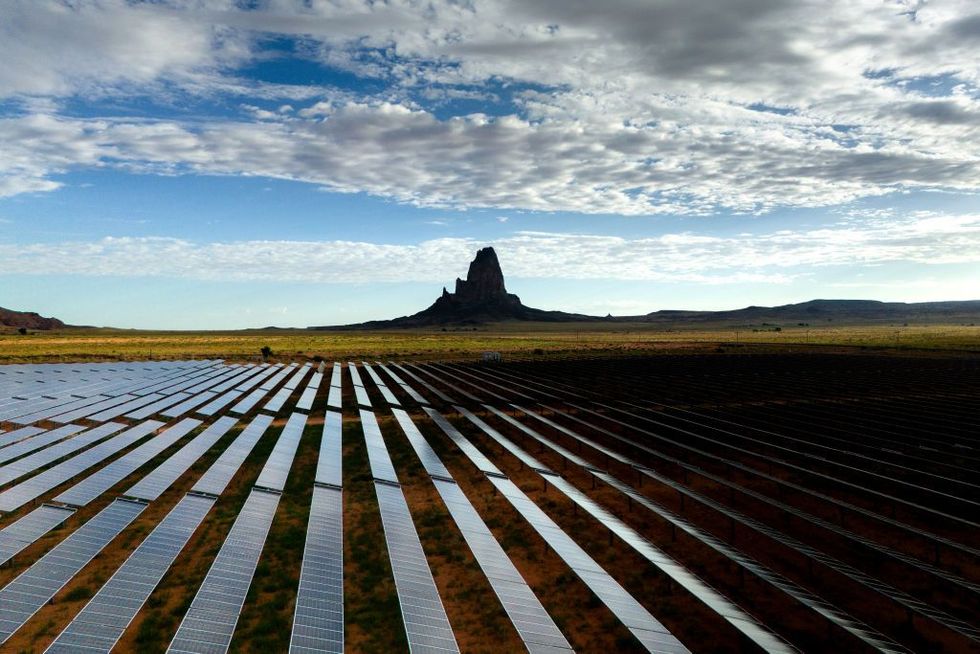Current conditions: In the Atlantic, Tropical Storm Fernand is heading northward toward Bermuda • In the Pacific, Tropic Storm Juliette is active about 520 miles southwest of Baja California, with winds of up to 65 miles per hour • Temperatures are surging past 100 degrees Fahrenheit in South Korea.
THE TOP FIVE1. U.S. renewables investment plunges by 36% this year

In the United States, investments in renewable energy fell by 36% — equal to $20.5 billion — compared to the second half of last year, according to new data from the consultancy BloombergNEF. The drop “reflects a rush of construction toward the end of last year as developers sought to lock in lucrative tax credits, followed by a sharp drop this year as policy conditions worsened,” the report stated. The European Union, on the other hand, ratcheted up spending on renewables by 63% — or nearly $30 billion — in the first half of this year compared to the second half of 2024. Drawing an even sharper contrast, investments into both onshore and offshore wind made up the bulk of the growth in Europe as the Trump administration has placed the harshest restrictions on wind turbines of any other energy source.
Overall, global investment into clean energy rose 10% in the first half of 2025 compared to the same period in 2024. That included a worldwide increase in wind investments of 24% and a jump in new solar investment of 5%.
2. Trump is going after yet another wind project.
The U.S. Geological Survey released its latest list of critical minerals on Monday. The report highlights some shifts in U.S. production and concerns in Washington over potential supply disruptions from supposedly friendly powers. While the analysis identifies China as the biggest threat to the U.S. economy in 46 of the 84 commodities studied, “Canada and South Africa both show up as potential points of disruption across eight imports,” Farrell Gregory, a non-resident fellow at the Foundation for American Innovation, wrote on X. “Interestingly, Canada is identified as having a high-risk for disruption, more than South Africa and Russia.”
There were new bright spots in the report. The USGS removed tellurium, a silvery brittle metal used in semiconductors, from the list of risk resources it was added to in 2022. That’s because a new Rio Tinto mine transformed the U.S. from an importer into a net exporter in recent years.
3. The U.S. updates its list of critical minerals
It could have been worse. The Treasury guidance issued Friday dictating what wind and solar projects will be eligible for federal tax credits could have effectively banned developers from tapping the write-offs set to start phasing out next July. In the weeks before the Internal Revenue Service released its rules, GOP lawmakers from states with thriving wind and solar industries, including Senators John Curtis of Utah and Chuck Grassley of Iowa, publicly lobbied for laxer rules as part of what they pitched as the all-of-the-above “energy dominance” strategy on which Trump campaigned. Grassley went so far as to block two of Trump’s Treasury nominees “until I can be certain that such rules and regulations adhere to the law and congressional intent,” as Heatmap’s Matthew Zeitlin covered earlier in August.
Since the guidance came out on Friday, both Grassley and Curtis have put out positive statements backing the plan. “I appreciate the work of Secretary [Scott] Bessent and his staff in balancing various concerns and perspectives to address the President’s executive order on wind and solar projects,” Curtis said, according to E&E News. Calling renewables “an essential part of the ‘all of the above’ energy equation,” Grassley’s statement said the guidance “seems to offer a viable path forward for the wind and solar industries to continue to meet increased energy demand” and “reflects some of the concerns Congress and industry leaders have raised.”
4. The U.S. isn’t pivoting to natural gas
Gas power plants are booming in the U.S. as demand surges, but the growth doesn’t yet mark a fundamental shift away from renewables, clean-energy analyst Michael Thomas wrote in a post on his Substack newsletter, Distilled. “If there were to be an unprecedented pivot to gas, you’d expect Texas to be ground zero for it,” he said. “The state has done everything it can to prop up fossil fuel power in recent years. It’s also one of the most permissive when it comes to environmental regulations and permitting.” Despite major growth in the past year, he wrote, gas made up just 10% of proposed new project capacity in Texas so far this year. The remaining 90% of capacity came from solar, wind, and battery projects. Last year alone, renewable and storage developers proposed 100 gigawatts of clean capacity — seven times more than gas developers proposed.
5. Map launches to track gas risks
A new map allowing users to track risks from natural gas super-emitters launched Tuesday from the independent energy science and policy institute PSE Healthy Energy. The Methane Risk Map is a web tool with clickable markers representing individual methane super-emitting events throughout the U.S. Selecting one, as Heatmap’s Emily Pontecorvo wrote, “opens up a heatmap and information panel that shows the concentration of benzene, methane, and other pollutants present in that particular plume, the modeled distance each one traveled during the event, the demographics of the population exposed, and whether there were any sensitive facilities, such as schools or hospitals, in the exposure pathway.”
Though methane, the primary component of natural gas, is an extremely potent greenhouse gas and can pose an explosive risk at high concentrations, other components in unrefined natural gas present more direct public health risks. These include carcinogens like benzene and other health-harming substances, including toluene.
THE KICKER
The grid-tech startup Splight has raised nearly $13 million to fund the commercial scaling of its breakthrough software. Unlike dynamic line rating, which uses weather and temperature data to open up more space on existing power lines to funnel as much as 30% more electricity, Splight claims its “dynamic congestion management” software can double the amount of room for electrons to flow without building new grid infrastructure.
